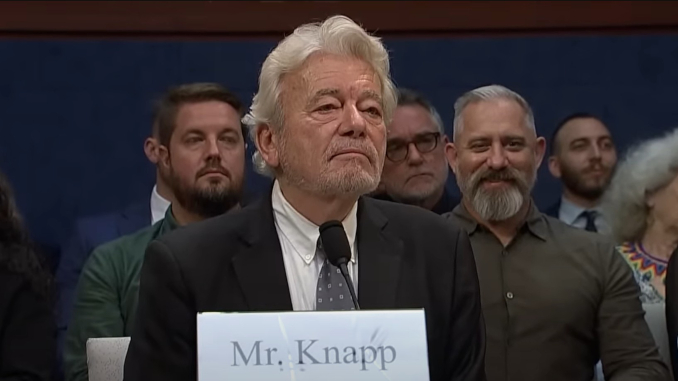
By José Niño
The Sept. 9, 2025, House Oversight Committee hearing on Unidentified Anomalous Phenomena (UAP) transparency delivered stunning, never-before-seen military footage of a Hellfire missile apparently striking—and deflecting off—an unidentified object near Yemen. The dramatic video, revealed by Rep. Eric Burlison (R-Mo.), shows what appears to be an extraordinary failure of one of America’s most destructive precision weapons against an unknown target.
Click the Link Below to Listen to the Audio of this Article
The centerpiece footage, recorded on Oct. 30, 2024, shows two MQ-9 Reaper drones tracking an orb-shaped object off Yemen’s coast during active U.S. military operations against Ansar Allah forces. The video appears to capture a Hellfire missile striking the object, which then continues its trajectory, seemingly unaffected. The timing is notable, occurring just one day after the Houthis announced drone attacks on Israel.
“We’ve never seen a Hellfire missile hit a target and bounce off,” explained former Pentagon UAP official Luis Elizondo. “When a Hellfire makes a hit, there’s usually not much left of whatever it’s hitting. It’s very destructive.”
The Pentagon has refused to authenticate the footage, with defense officials consistently telling reporters, “We do not have anything further to provide on this.”
The hearing featured unprecedented testimony from five military veterans and experts, with three stating unanimously that no known U.S. technology could withstand a direct Hellfire missile strike.
Jeffrey Nuccetelli, a 16-year Air Force veteran, testified about five separate UAP incidents at Vandenberg Air Force Base between 2003 and 2005, including one where he witnessed a “massive red square” hovering over missile defense sites, and a rectangular craft “larger than a football field.”
Chief Alexandro Wiggins became the first active-duty Navy official to testify publicly before Congress about a UAP incident. His Feb. 15, 2023 encounter aboard USS Jackson involved four “Tic Tac”-shaped objects emerging from the Pacific Ocean, captured on multiple military sensor systems.
Dylan Borland, a former Air Force intelligence analyst, described a 2012 encounter at Langley AFB with a 100-foot triangular craft that interfered with his telephone and displayed “fluid or dynamic” material properties.
All witnesses described systematic retaliation against personnel who reported UAP sightings, including career damage and security clearance manipulation.
Hellfire missiles represent some of the most capable precision weapons in the U.S. arsenal. The AGM-114 series weighs 45–49 kg, travels at Mach 1.3, and features high-explosive anti-tank shaped charges capable of defeating any known tank. No terrestrial materials are known to withstand such an impact, according to military experts queried on the subject.
When Rep. Anna Paulina Luna (R-Fla.) asked witnesses if they were aware of anything in the U.S. arsenal that could survive a Hellfire strike, all answered negatively.
Despite the extraordinary testimony, rigorous analysis points to conventional explanations. Harvard physicist Avi Loeb conducted detailed technical analyses suggesting the object was likely an Ansar Allah Samad drone rather than some kind of anomalous technology.
Using the known 1.6-meter length of the Hellfire missile for scale, Loeb calculated the UAP at “a few meters in size”—consistent with Samad drone dimensions. The object’s speed of approximately 70 meters per second also matches known Samad capabilities. Loeb suggests the missile likely grazed the drone peripherally without triggering a warhead detonation.
Defense publication The War Zone noted the object’s “very balloon-like” behavior and identified parallax effect as a likely cause of its apparent anomalous speed—an optical illusion that can make slow-moving objects appear extremely fast when viewed from multiple angles.
This hearing was the fourth major UAP session since 2022, following the accelerating timeline of disclosure efforts. Previous hearings included:
- May 2022 House Intelligence hearing, the first public UAP hearing in more than 50 years.
- July 2023 hearing featuring David Grusch’s whistleblower testimony about crash-retrieval programs.
- Nov. 2024 joint hearing on UAP oversight.
Government UAP investigations have evolved from the 2007–2012 Advanced Aerospace Threat Identification Program to today’s All-domain Anomaly Resolution Office (AARO). However, witnesses expressed skepticism about AARO’s effectiveness, with Chairwoman Luna calling former director Sean Kirkpatrick “a documented liar.”
The hearing also featured investigative journalist George Knapp, who warned: “There are servers where there’s a whole bank of these kinds of videos that Congress has not been allowed to see.”
Media coverage proved extensive across major outlets, though careful language emphasized what the video “appears” to show rather than making definitive claims. Congressional reactions crossed party lines, with lawmakers pressing for increased transparency.
The footage remains unauthenticated by Pentagon officials, lacks corroborating multi-sensor data, and emerged from anonymous sources rather than official channels. This aligns with AARO patterns, which has resolved hundreds of UAP reports as “commonplace objects such as balloons, birds, drones, satellites, and aircraft.”
Whether the Yemen footage shows extraordinary technology or a conventional drone strike gone awry, the hearing advanced UAP transparency efforts. The most significant outcome may be establishing protected channels for military personnel to report unusual encounters without career retaliation.
The Yemen missile incident will likely remain controversial, but the hearing succeeded in forcing important questions about government transparency, protection of military witnesses, and the need for scientific rigor when investigating phenomena that challenge our understanding of known technology and physics.
As witness Joe Spielberger emphasized, strengthening whistleblower protections remains essential for genuine transparency.

















